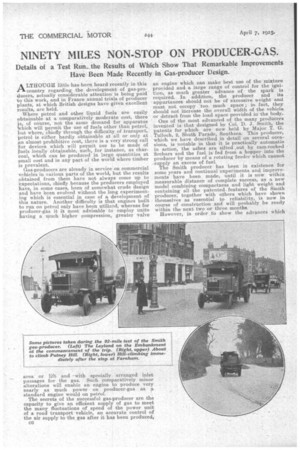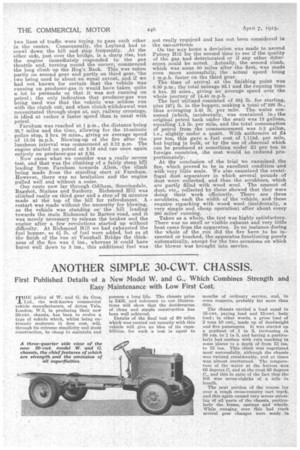NINETY MILES NON-STOP ON PRODUCER-GAS.
Page 10

Page 11

Page 12

If you've noticed an error in this article please click here to report it so we can fix it.
of a Test Run_the Results of Which Show That Remarkable Improvements Have Been Made Recently in Gas-producer Design.
ALTHOTJGH little has been heard recently in this country regarding the development of gas-producers, actually considerable attention is being paid to this work, and in France annual trials of producer plants, at which British designs have given excellent results, are held.
Where petrol and other liquid fuels are easily obtainable at a comparatively moderate cost, there is, of course, not the same demand for apparatus 'which will permit the use of fuels other than petrol, but where, chiefly through the difficulty, of transport, Petrol is either hardly obtainable at all or only at ,1.11 almost prohibitive cost, there is a very strong call for devices which will permit use to be made of fuels locally obtainable, such, for instance, as charcoal, which which can be produced in large quantities at small cost and in any part of the world where timber is prevalent.
Gas-producers are already in service on commercial vehicles in various parts of the world, but the results pbtained from them have not always come up to 'expectations, chiefly because the producers employed have, in some cases, been of somewhat crude design and have been evolved without the long experimenting which is essential in case of a development of this nature. Another difficulty is that engines built to run on petrol only have been utilized, whereas for producer-gas it it most advisable to employ units having a much higher compression, greater valve an engine which can make best use of the mixture provided and a large range of control for the ignition, as much greater advance of the spark is required. In addition the producer and its appurtances should not? be of excessive weight and must not occupy too much space ; in fact, they should not increase the overall width of the vehicle or detract from the load space provided in the body. One of the most advanced of the many producers invented is that designed by Col. D. J. Smith, tho patents for which are now held by Major T. G. Tulloch, 2, South Parade, Southsea. This producer, which we have described in detail on several occasions, is notable in that it is practically automatic in action, the ashes are sifted ,out by cam-rocked firebars and the fuel is fed from a hopper into the producer by means of a rotating feeder which cannot supply an excess of fuel. The Smith producer has been in existence for some years and continual experiments and improvements have been made, until it is now within measurable distance of complete success, as a new model combining compactness and light weight and containing all the patentedfeatures of the Smith producer, together with others which have shown themselves as essential to reliability, is now in course of construction and will probably be ready within the next two or three months.
However, in order to show the advances which
have already been made one day last week we carried out an extensive test with a 4-ton Leyland lorry equipped with a Smith producer, which, although not of the new pattern, yet embodied the majority of the new features, which were added by Mr. H. C. Reading, A.M.I.A.E., of the Lorry Maintenance Co., 162, Grosvenor Road, London, S.W.1, Who has taken over the work of designing the producer on really practicable lines.
The Leyland was one in which the power unit had been slightly modified, although not so much as is desirable, by raising the compression from 75 lb. per sq. in. to 100 lb. per sq. in, and increasing the lift of the valves by .11 in., but being otherwise standard. The producer on this vehicle is fitted into the side of the driver's cab so that it does not extend beyond the cab and yet permits the fitting of a second seat beside the driver. Behind the cab is carried a specially large hopper for the supply of the fuel, which consisted of anthracite beans.
The chassis weight is 3 tons 5 cwt. and the temporary body, the load and the producer together weighed 4 tons, making a total of 7 tons 5 cwt., of which the producer alone took about 7 cwt.—a weight which will soon be reduced very materially. A very careful record was made of the fuel carried in the hopper and that used for setting the appliance in action in the first instance. Actually, 28;12 lb. were fed by hand into the producer during this operation. Lighting-up took place at 9.53 a.m. sticks soaked in paraffin being inserted into the combustion chamber. The blower was then operated by hand and within eight minutes the gas issuing from the vent, pipe of the producer was lighted and burnt with a clear flame. The engine was started up on . petrol at 10.10 a.m., ran on a mixture of petrol and • producer-gas at 10.12, and on producer-gas alone at 10.12?,„ a start being made from Vauxhall Bridge at 10.14, at which point the trip recorder was set at zero.
We were surprised to note that from the veryfirst there was not the slightest sign of hesitation on the part of the engine. It seemed to take to producer-gas as if this were quite its natural fuel, and no missing occurred, although several stops for traffic had to be made before we had proceeded more than a few yards. • A steady run was then made to Putney, and Putney Hill was ascended at 10 m.p.h, on third speed with the engine pulling strongly and easily and with in. of vacuum in the gaspipe leading to the engine, this being shown by a U tube carrying mercury, fitted in the cab in front of the driver and connected to the gaspipe by means of a rubber pipe. This gauge forms a valuable guide to the supply of fuel and it will probably be embodied in future as part of the equipment.
At Kingston came the only involuntary stop of the runt and this was caused by the police, who were
• anxious to know why we were "joy riding" with trade number plates. The delay thus caused occupied some 10 minutes and, as a precautionary measure, the blower was brought into action for a minute or so before a fresh start was made.
A good steady run was then made past Wisley Hut through Ripley to Guildford. It being market day, the streets were congested to an appalling extent. On the famous hill there was a, line of stationary vehicles at each side of the road, whilst
-two lines of traffic were trying to pass each other in the centre. Consequently, the Leyland had to crawl down the hill and stop frequently. At the other side, just over the bridge, is a sharp rise, but the engine immediately responded to the gas throttle and, turning round the corner commenced the long climb up the Hog's Back. This was taken partly on second gear and partly on third gear, the two being used to about an equal extent, and if we had not known for certain that the vehicle was running on producer-gas it would have taken quite a lot to persuade us that it was not running on petrol; the only indication that producer-gas was being used was that the vehicle was seldom run with the clutch out, and when clutch withdrawal was necessitated through stops at, say, railway crossings, it idled at rather, a faster speed than is usual with petrol. Farnham was reached at 1 p.m., the distance being 36.7 miles and the time, allowing for the 10-minute police stop, 2 hrs. 36 mitts., giving an average speed of 15.04 m.p.h. Blowing-up of the fire after the luncheon interval was commenced at 2.12 p.m. The engine started on petrol at 2.19 and ran once again entirely on producer-gas at 2.24. • Now came what we consider was a really severe test, and that was the climbing of a fairly steep Mil leading from Farnham towards Alton, the climb being made from the standing start at Farnham. However, there was no hesitation and the engine pulled well and without a noise.
Our route now lay through Odiham, Sunningdale, Bagshot, Staines and Sunbury. Richmond Hill was climbed easily on third gear and a stop of 2Q minutes made at thetop of the hill for refreshment. A restart was made without the necessity for blowing, as the vehicle was standing on the bill leading towards the main Richmond to Barnes road, and it was merely necessary to release the brakes and the engine after a few revolutions started up without difficulty. At Richmond Hill we had exhausted the fuel hopper, so 6-3/4 lb. of fuel were added, hut as at the finish of the run at Vauxhall Bridge the thickness of the fire was 5 ins., whereas it could have burnt well down to 3 ins., this additional fuel was not really. required and has not been considered in the caicutrtionsi On the way home a deviation was made to ascend Putney Hill for the second time to see if the quality of the gas had deteriorated or if any other differences could be noted. Actually, the second climb, which was some SO -miles after the first, was Made even more successfully, the actual speed being 1 m.p.h. faster on the third gear.
The time of arrival at the finishing point was 6.30 p.m., the total mileage 92.1 and the running time 6 hrs. 22 mins., giving an average speed over the whole journey of 14.48 m.p.h.
The fuel utilized consisted of 283/4 lb. for starting, plus 1971 lb. in the hopper, making a total of' 226 lb., thus averaging 2.45 lb. per mile. The water consumed (which, incidentally, was contained in athe original petrol tank under the seat) was 12 gallons, equalling 1.3 lb. per mile, and the total consumption of petrol from the commencement was 0.2 gallon i.e., slightly under a quart. With anthracite at .F.,4 per ton, this gave a fuel cost. of 1.115d. per mile, but buying in bulk, or by the use of charcoal which can be produced at something under 21 per ton in foreign countries, the cost would be reduced proportionately. At the conclusion of the trial we examined the fire, which proved to be in excellent condition and with very little scale. We also examined the centrifugal dust separators in which several pounds of dust were collected, and then the. scrubbers, which are partly filled, with wood wool. The amount of dust, etc., collected by these showed that they were doing their, work efficiently. There are three
• scrubbers, each the width of the vehicle, and these require repacking with wood wool (incidentally, a very simple and cheap operation) after about every 200 miles running. , Taken as a whole, the test was highly satisfactory. There was no smell or visible exhaust and very little beat came from the apparatus. In no instance during the whole of the run did the fire have to be inspected or touched, the apparatus functioning purely automatically, except for the two occasions on which the blower was brought into service.




























